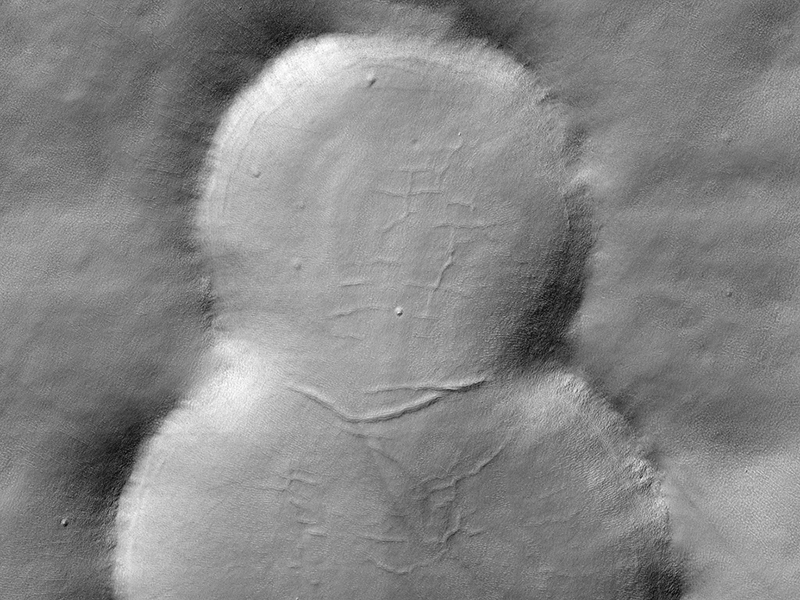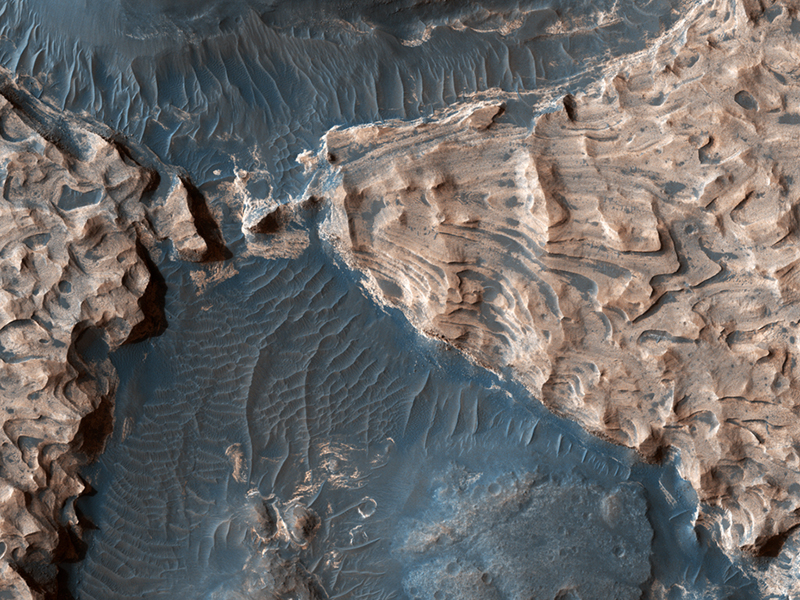HiRISE Updates Week of 2018 Jul 09
Posted: Wed Jul 18, 2018 8:10 pm
Author wrote:Figure 8 Craters on Mars (ESP_054940_2385) (HiClip)
Impact craters are very common on the surface of Mars as well as any other planetary body lacking a significant atmosphere (e.g., the Moon). In the absence of a thick atmosphere and active geologic processes, and if the surface is very old and has not been altered by something like lava flows, it will retain evidence of so many impacts that older and newer craters appear like circles on top of each other.
When we see a combination of two crater shapes on the ground, the one showing a nearly “full circle” will be the younger crater. In this image, we see the combined shape of two impact craters. However, neither crater displays a continuous circular shape (or rim) in the area connecting them. These two “figure 8” shapes indicate a binary impact where the impactor split apart shortly before hitting the ground, creating both craters at the same time.
Jennifer Newman, Sarah Simpson, Alyssa Werynski, Livio Tornabene wrote:Jamming with the “Spiders” from Mars (ESP_055283_0985)
(HiClip)
During winter at the South Pole of Mars, a carbon dioxide ice cap covers the region and as the sun returns in the spring, “spiders” begin to emerge from the landscape.
But these aren’t actual spiders. We call it “araneiform terrain,” to describe the spider-like radiating channels that form when carbon dioxide ice below the surface heats up and releases. This is an active seasonal process we don’t see on Earth. Like dry ice on Earth, the carbon dioxide ice on Mars sublimates as it warms (changes from solid to gas) and the gas becomes trapped below the surface.
Over time the trapped carbon dioxide gas builds in pressure and is eventually strong enough to break through the ice as a jet that erupts dust. The gas is released into the atmosphere and darker dust may be deposited around the vent or transported by winds to produce streaks. The loss of the sublimated carbon dioxide leaves behind these spider-like features etched into the surface.
Ginny Gulick wrote:Uplifted Blocks of Light-Toned Layered Deposits
(ESP_054753_1825) (HiClip)
Aram Chaos lies within a 280 kilometer-diameter ancient impact crater in the Southern Highlands of Mars. Uplifted blocks of light-toned layers, composed largely of the iron-oxide hematite and water-altered silicates, indicate that this crater once held a lake.
Scientists suggest that these enormous flood channels were carved quickly within just weeks or months by catastrophic outflows of groundwater over 2.5 billion years ago from beneath Aram Chaos and nearby regions. Today dark (basaltic) dunes fill most of the low regions and the etched areas of the uplifted blocks obscure much of the original crater floor.
Aram Chaos is located near the headwaters of Ares Vallis, a large outflow channel system that extends about 1700 kilometers towards the northwest across the ancient cratered highlands before emptying into the Northern Lowlands at Chryse Planitia near the Mars Pathfinder landing site.
This is a stereo pair with ESP_055452_1825.
Cathy Weitz wrote:Clays in the Eridania Basin (ESP_055392_1510) (HiClip)
This colorful image shows clays within the Eridania basin region. Many scientists using orbital data have proposed that a large lake may have once existed here during the Late Noachian through Early Hesperian time periods, and then much of the water drained out to the north via Ma’adim Vallis.
Understanding where and what kind of clay exists within this region using CRISM data can help scientists learn more about how long the postulated lake existed and the water chemistry within the lake.
This is a stereo pair with PSP_010888_1510.
Credit: NASA/JPL-Caltech/University of Arizona
<< Previous HiRISE Update



